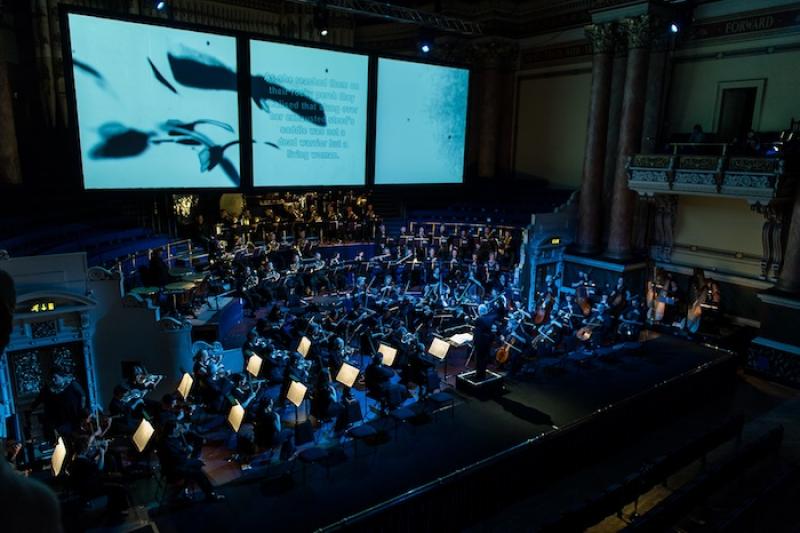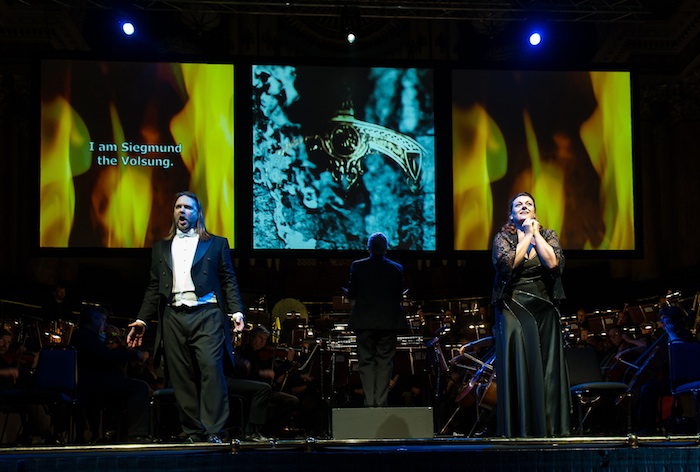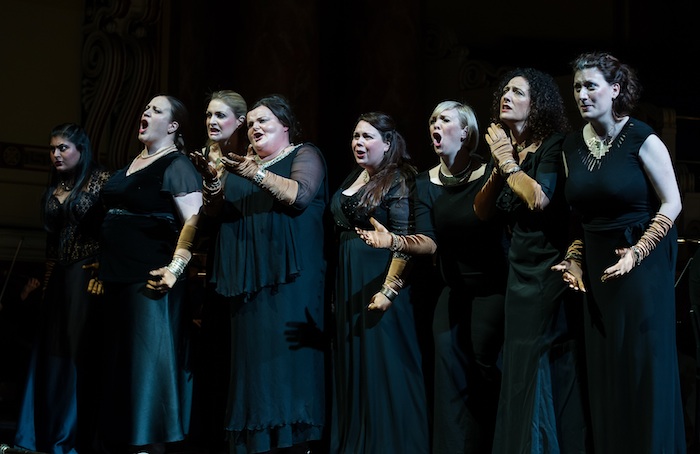Die Walküre, Opera North | reviews, news & interviews
Die Walküre, Opera North
Die Walküre, Opera North
No-frills concert staging provides plenty of vocal thrills

This works as well as it did last year – a no-frills approach to Wagner that helps far more than it hinders. Forget fat ladies wearing Viking helmets. Here the intimacy, the surprising humanity of Die Walküre come to the fore in what seems more and more like an opera cycle narrating a complex, tragic family saga, focusing on a father’s inability to control his daughters.
Practical considerations, namely an orchestra pit too small to accommodate Wagnerian forces, have led Opera North to mount their Ring Cycle as a semi-staged production in Leeds’s spectacular Victorian town hall, after which it goes on tour to Salford, Newcastle and Birmingham. As with 2011’s Das Rheingold, Peter Mumford’s staging uses clever lighting and three vast video screens suspended above an augmented orchestra to join the dots - an economical, practical artistic decision that works supremely well. Staging Wagner in a manner that will please everyone is a near-impossible task. These screens fill in the gaps nicely, while the singers can act to varying degrees in front of the musicians.
 A dauntingly long evening flies by – the orchestral playing is world class, and Richard Farnes‘s clear-sighted conducting is a marvel. You hear everything you need to, and the singers are rarely overwhelmed. It’s all beautifully paced, with an extended final scene played with touching sweetness, just at the point where you expect the musicians to be falling off their chairs with fatigue. Die Walküre is a more tender work than its predecessor, Despite the vast forces, the mood is often introspective and chamber-like. The most telling moments are the most human, small-scale ones – Wotan’s discussions with Brünnhilde, or Sieglinde’s exchanges with Siegmund and Hunding in Act One (pictured above).
A dauntingly long evening flies by – the orchestral playing is world class, and Richard Farnes‘s clear-sighted conducting is a marvel. You hear everything you need to, and the singers are rarely overwhelmed. It’s all beautifully paced, with an extended final scene played with touching sweetness, just at the point where you expect the musicians to be falling off their chairs with fatigue. Die Walküre is a more tender work than its predecessor, Despite the vast forces, the mood is often introspective and chamber-like. The most telling moments are the most human, small-scale ones – Wotan’s discussions with Brünnhilde, or Sieglinde’s exchanges with Siegmund and Hunding in Act One (pictured above).
Opera North’s General Director Richard Mantle announced that Annalena Persson, due to sing Brünnhilde, had been laid low by a throat infection. Her replacement, American soprano Kelly Cae Hogan, had flown in from Berlin just hours before the performance. She's a marvel – vocally impressive, impetuous and possessing just enough vulnerability. Her dynamic range is huge, and she looks the part. Her extended scenes with Béla Perencz’s Wotan are electrifying; you’d never guess that the two singers had only just met. Perencz’s Wotan is intriguingly different to Michael Druiett’s portrayal in Das Rheingold. He’s smaller, shiftier, nervier, his body language reflecting his unease at seeing his comfortable existence slowly starting to unravel. His scenes with Katarina Karnéus’s imposing Fricka are exquisitely uncomfortable.
 There are only a few moments when you wish that the singers had the space to behave more credibly. Erik Nelson Werner’s Siegmund can’t help seeming slightly lost without a magic sword to grip on to, and he and his sister Sieglinde (Alwyn Mellor) would preferably edge a little closer together before they embrace at the close of Act One. But the video projections subtly illuminate the drama, as well as providing narration and subtitles. After the ethereal backgrounds of the first opera, Mumford’s opening arboreal shots are fast-moving, claustrophobic, vividly suggesting Siegmund’s panic as he races through the forest. There’s a lot of mud, water, and eventually blood – a pity that more fun wasn’t had with showing different images on different screens at the same time. Flickering flames recur several times, growing in intensity and brightness as Siegmund and Sieglinde declare their love, and glowing brightly in the opera’s final minutes as Brünnhilde lies encircled by fire.
There are only a few moments when you wish that the singers had the space to behave more credibly. Erik Nelson Werner’s Siegmund can’t help seeming slightly lost without a magic sword to grip on to, and he and his sister Sieglinde (Alwyn Mellor) would preferably edge a little closer together before they embrace at the close of Act One. But the video projections subtly illuminate the drama, as well as providing narration and subtitles. After the ethereal backgrounds of the first opera, Mumford’s opening arboreal shots are fast-moving, claustrophobic, vividly suggesting Siegmund’s panic as he races through the forest. There’s a lot of mud, water, and eventually blood – a pity that more fun wasn’t had with showing different images on different screens at the same time. Flickering flames recur several times, growing in intensity and brightness as Siegmund and Sieglinde declare their love, and glowing brightly in the opera’s final minutes as Brünnhilde lies encircled by fire.
All fantastic. But you really need to snap up a ticket for the music. Few of the singers are household names, but none of them disappoints. Wagner’s endless melodies seduce as they unfurl, and the woodwind playing never sours; bass clarinet and cor anglais proving exceptionally impressive. There are no massed anvils in Die Walküre but fans of underused instruments will enjoy a rare chance to hear a contrabass trombone and the steerhorn which blasts out near the end of Act Two. And the Ride of the Valkyries (pictured above), the one moment in the opera where Wagner’s subtlety and good taste seem questionable, is a blast, the melody roaring out on bass trumpet as the eight Valkyries enter one by one and stand in formation. Farnes resists bombast, making the music swagger and soar. Delicious.
Watch the trailer for Die Walküre
- 'Die Walküre is at Leeds Town Hall, then on tour to Gateshead, Salford and Birmingham
rating
Explore topics
Share this article
Add comment
The future of Arts Journalism
You can stop theartsdesk.com closing!
We urgently need financing to survive. Our fundraising drive has thus far raised £49,000 but we need to reach £100,000 or we will be forced to close. Please contribute here: https://gofund.me/c3f6033d
And if you can forward this information to anyone who might assist, we’d be grateful.

Subscribe to theartsdesk.com
Thank you for continuing to read our work on theartsdesk.com. For unlimited access to every article in its entirety, including our archive of more than 15,000 pieces, we're asking for £5 per month or £40 per year. We feel it's a very good deal, and hope you do too.
To take a subscription now simply click here.
And if you're looking for that extra gift for a friend or family member, why not treat them to a theartsdesk.com gift subscription?
more Opera
 The Makropulos Case, Royal Opera - pointless feminist complications
Katie Mitchell sucks the strangeness from Janáček’s clash of legalese and eternal life
The Makropulos Case, Royal Opera - pointless feminist complications
Katie Mitchell sucks the strangeness from Janáček’s clash of legalese and eternal life
 First Person: Kerem Hasan on the transformative experience of conducting Jake Heggie's 'Dead Man Walking'
English National Opera's production of a 21st century milestone has been a tough journey
First Person: Kerem Hasan on the transformative experience of conducting Jake Heggie's 'Dead Man Walking'
English National Opera's production of a 21st century milestone has been a tough journey
 Madama Butterfly, Irish National Opera review - visual and vocal wings, earthbound soul
Celine Byrne sings gorgeously but doesn’t round out a great operatic character study
Madama Butterfly, Irish National Opera review - visual and vocal wings, earthbound soul
Celine Byrne sings gorgeously but doesn’t round out a great operatic character study
 theartsdesk at Wexford Festival Opera 2025 - two strong productions, mostly fine casting, and a star is born
Four operas and an outstanding lunchtime recital in two days
theartsdesk at Wexford Festival Opera 2025 - two strong productions, mostly fine casting, and a star is born
Four operas and an outstanding lunchtime recital in two days
 The Railway Children, Glyndebourne review - right train, wrong station
Talent-loaded Mark-Anthony Turnage opera excursion heads down a mistaken track
The Railway Children, Glyndebourne review - right train, wrong station
Talent-loaded Mark-Anthony Turnage opera excursion heads down a mistaken track
 La bohème, Opera North review - still young at 32
Love and separation, ecstasy and heartbreak, in masterfully updated Puccini
La bohème, Opera North review - still young at 32
Love and separation, ecstasy and heartbreak, in masterfully updated Puccini
 Albert Herring, English National Opera review - a great comedy with depths fully realised
Britten’s delight was never made for the Coliseum, but it works on its first outing there
Albert Herring, English National Opera review - a great comedy with depths fully realised
Britten’s delight was never made for the Coliseum, but it works on its first outing there
 Carmen, English National Opera review - not quite dangerous
Hopes for Niamh O’Sullivan only partly fulfilled, though much good singing throughout
Carmen, English National Opera review - not quite dangerous
Hopes for Niamh O’Sullivan only partly fulfilled, though much good singing throughout
 Giustino, Linbury Theatre review - a stylish account of a slight opera
Gods, mortals and monsters do battle in Handel's charming drama
Giustino, Linbury Theatre review - a stylish account of a slight opera
Gods, mortals and monsters do battle in Handel's charming drama
 Susanna, Opera North review - hybrid staging of a Handel oratorio
Dance and signing complement outstanding singing in a story of virtue rewarded
Susanna, Opera North review - hybrid staging of a Handel oratorio
Dance and signing complement outstanding singing in a story of virtue rewarded
 Ariodante, Opéra Garnier, Paris review - a blast of Baroque beauty
A near-perfect night at the opera
Ariodante, Opéra Garnier, Paris review - a blast of Baroque beauty
A near-perfect night at the opera
 Cinderella/La Cenerentola, English National Opera review - the truth behind the tinsel
Appealing performances cut through hyperactive stagecraft
Cinderella/La Cenerentola, English National Opera review - the truth behind the tinsel
Appealing performances cut through hyperactive stagecraft

Comments
I can't wait ~!!!! So much
So exciting I could not sleep
You're right, Mike. I've
We agree that the orchestra